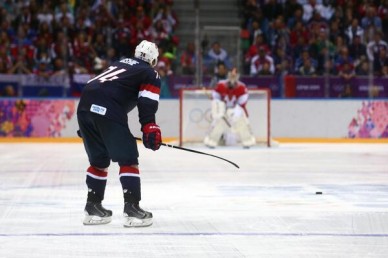 TEAM USA – TEAM RUSSIA: WHAT WE LEARNED
TEAM USA – TEAM RUSSIA: WHAT WE LEARNED The Americans thrilling 3-2 shootout win over Russia was a fantastic game that had just about everything. The game appears to have caught the attention of so many around the United States and it’s all anyone seems to be talking about which is great to see.
T.J. Oshie (4-or-6 in shootout) had the heroics, scoring four times in the shootout, and beat Sergei Bobrovsky between legs in the eighth round for the epic win.
Oshie who the casual hockey fan probably never heard of, has suddenly become a household name. He got a shout out from the White House to gaining almost 100,000 twitter followers today since scoring the game winning goal. He started the day at 90,000 and now has 190,000 followers as of 8:00 p.m. Oshie was asked by a reporter on how he it feels to be an American hero. His answer: “I’m not a hero, real heroes are wearing Camo”. You can’t ask for a better answer than that.
Oshie’s excellent ability and skill set in the shootout is no secret and a big reason Oshie made this hockey club.
“I aged a couple of years in that shootout,” head coach Dan Bylsma said. “We had other guys that are capable, but T.J. was the guy who was going well. It seemed like he was going to score every time he went.”
The Americans, 2-0, are now in prime position to win their group and what we’ve learned about the Americans through two games is that they play like a team that has their eye on the prize. Players know their roles and from Ryan Kesler to Ryan McDonagh laying their bodies on the line to block shots (NHL clubs hate to see that right now), the effort has been tremendous from lines one through four to the seven defensemen dressing.
There’s a lot to like with Jonathan Quick in goal, an excellent shutdown pairing in Ryan Suter and Ryan McDonagh, and a well rounded forward group with some game breakers in the likes of Patrick Kane and Phil Kessel.
However, the team I came away more impressed with was the Russian’s from the standpoint that I’ve been very skeptical of Russia’s blueline and whether they had enough sandpaper to their game. On the big ice surface, having sandpaper in your lineup is not as important but Russia matched the physicality of the Americans well and the ice was tilted in the Russian’s favor a bit at even strength. One feeling was Team USA would be able to wear down the Russian’s on the cycle and in around and behind the net, but the Russian’s were effective at getting the puck out of their zone quickly and it’s a very dangerous group in transition on the big ice.
Let’s be honest, Team USA was lucky to win this one after a goal from Fedor Tyutin was disallowed with 4:40 left in the third period that preserved a 2-2 tie.
Aside from T.J. Oshie, the story of the game was Pavel Datsyuk. Datsyuk who had two goals in the game, was without question the best player on the ice and played a dominant two-way game. Clearly not 100%, as there were some questions as to whether he’d even be able to play in the Olympics, Datsyuk looked like the player he was five years ago, blowing by Brooks Orpik in the neutral zone for a breakaway goal in the second period.
Watching Datsyuk today, you have to feel bad for the team that signs his paycheck, the Detroit Red Wings. Datsyuk played in just 1 of the Red Wings last 15 games prior to the Olympic break due to a knee injury and with him believed to still be playing injured and pretty much pouring his heart out for Russia at the Olympics, would it really be a shock that he gets worn down during the Olympics and never gets back to full health down the stretch for the Red Wings who are fighting for every point to make the playoffs.
POST-GAME CHATTER
— Evgeni Malkin was shutout in the game but I didn’t recognize the player I was watching as Malkin was back checking with authority like he was Pavel Datsyuk and Malkin was a physical force early on. You don’t see that often from him in a Penguins uniform. Malkin was credited with 4 shots and struggled in the faceoff circle, winning 7 of 21 draws.
— Bylsma relied heavily on his shutdown pairing of Ryan Suter and Ryan McDonagh. Suter played 29:56 and McDonagh played 23:39. For Suter that’s just another day at the office. With the Wild he is often hitting 30 minutes per game.
— Brooks Orpik saw a significant increase in ice time. He played 7:12 in the first period after playing just 1:26 in the first period vs Slovakia. Orpik played 16:38 vs Russia, 5th among defensemen. Paul Martin was sixth among defensemen with 15:47 of ice time. Martin was very strong in the third period.
— Blake Wheeler took a bad penalty in the neutral zone in the first period, something you can’t do as the 13th forward, and that would be his last shift. He played just two shits and 0:38 in the game. Wheeler played just 4:47 vs Slovakia and Bylsma has not seemed like a big fan of Wheeler’s. As the tourney progresses and if Team USA is struggling to score at 5-on-5, questions will mount if the management missed on bringing Wheeler instead of Kyle Okposo or Bobby Ryan.
Fans who don’t get to see Joe Pavelski much, are seeing how good of a hockey player he is.
